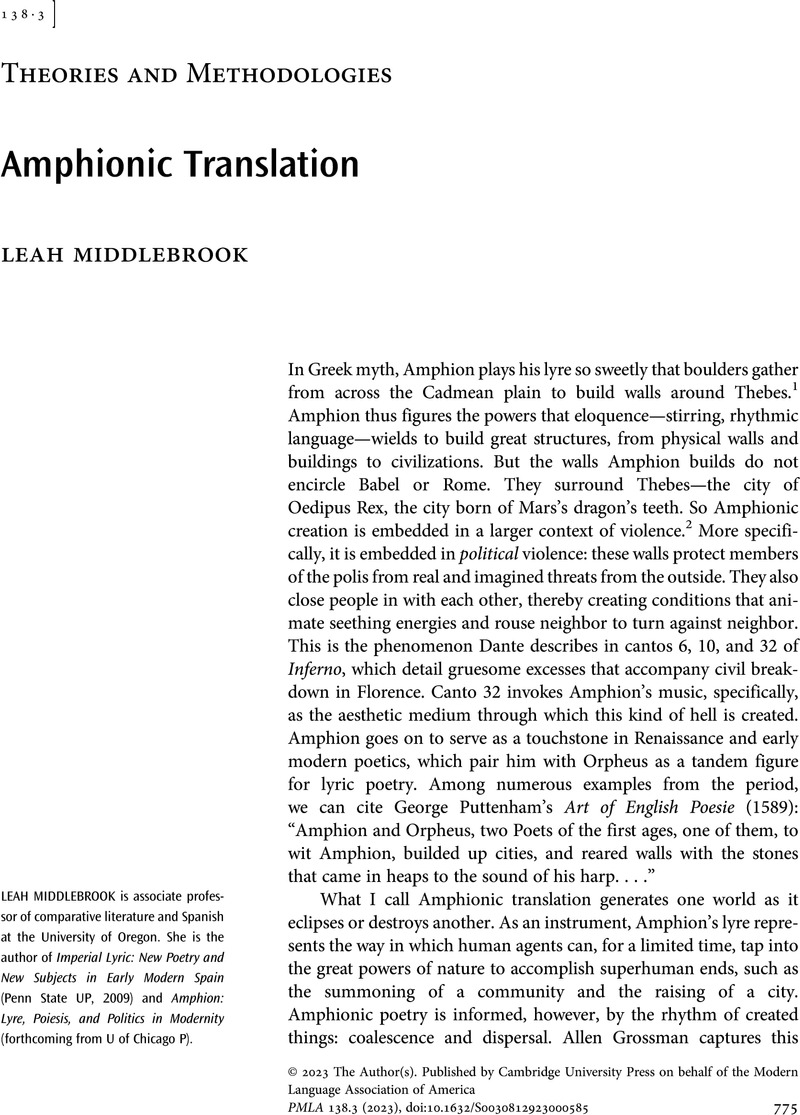No CrossRef data available.
Article contents
Amphionic Translation
Published online by Cambridge University Press: 12 September 2023
Abstract
An abstract is not available for this content so a preview has been provided. Please use the Get access link above for information on how to access this content.

- Type
- Theories and Methodologies
- Information
- Copyright
- Copyright © 2023 The Author(s). Published by Cambridge University Press on behalf of the Modern Language Association of America
References
Works Cited
Acuña, Hernando de. “A un buen caballero y mal poeta: La lira de Garcilaso contrahecha.” Biblioteca Nacional de España. MS. 1475.Google Scholar
Acuña, Hernando de. El cavallero determinado traduzido de la lengua francesa en castellana por Don Hernando de Acuña, y dirigido al Emperador Don Carlos Quinto Maximo Rey de España Nuestro Señor. Johannes Steelsius, 1553.Google Scholar
Clavería, Carlos. Le chevalier délibéré de Olivier de la Marche y sus versiones españolas del siglo XVI. Zaragoza, 1950.Google Scholar
Coldiron, A. E. B. “Cultural Amphibians: Translation, Early Print, and the Comparative New Historicism.” Yearbook of Comparative Literature, vol. 51, 2003–04, pp. 43–58.Google Scholar
Dante, . Inferno. Edited and translated by Durling, Robert M., introduction and notes by Ronald L. Martinez and Durling, Oxford UP, 1996.Google Scholar
Emmerich, Karen. Literary Translation and the Making of Originals. Bloomsbury, 2017.CrossRefGoogle Scholar
Grossman, Allen. Summa Lyrica: A Primer of the Commonplaces in Speculative Poetics. The Sighted Singer: Two Works on Poetry for Readers and Writers, by Grossman with Halliday, Mark, Johns Hopkins UP, 1992, pp. 205–84.Google Scholar
Horace. Ars Poetica. Poetry Foundation, www.poetryfoundation.org/articles/69381/ars-poeticaI. Accessed 1 Aug. 2022.Google Scholar
La Marche, Olivier de. Le chevalier deliberé / The Resolute Knight. Translated by Wilson, Lois Hawley and Carroll, Carleton W., Arizona Center for Medieval and Renaissance Studies, 1999.Google Scholar
Newman, Karen, and Tylus, Jane. Introduction. Early Modern Cultures of Translation, edited by Newman, and Tylus, , U of Pennsylvania P, 2015, pp. 1–24.CrossRefGoogle Scholar
Ovid, . Metamorphoses. Translated by Humphries, Rolfe, annotated by Reed, Joseph D., Indiana UP, 2018.CrossRefGoogle Scholar
Sutch, Susie Speakman, and Prescott, Anne Lake. “Translation as Transformation: Oliver de La Marche's Le chevalier délibéré and Its Hapsburg and Elizabethan Permutations.” Comparative Literature Studies, vol. 25, no. 4, 1988, pp. 281–317.Google Scholar
Urrea, Jerónimo de. Discurso de la vida humana y aventuras del caballero determinado traduzido de Frances por Don Jerónimo de Urrea. Martin Nuntius, 1555.Google Scholar
Venuti, Lawrence. “The Poet's Version; or, An Ethics of Translation.” Translation Studies, vol. 4, no. 2, 2011, pp. 230–47.Google Scholar




